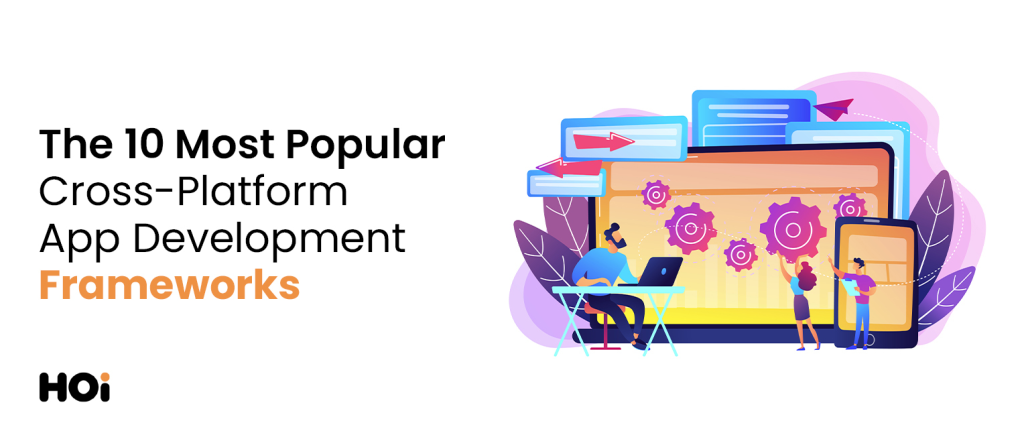The 10 Most Popular Cross Platform App Development Frameworks

The demand for cross platform app development services is surging, and for good reason. This development is not only cost-effective but also overcomes major challenges. Similarly, as the demand increases, several cross-platform app development tools and frameworks are also emerging in the market.
That’s not it! Once they become public, every other mobile app development company is leveraging that technology to achieve scalability and growth.
This leads to another problem. With so many cross-platform tools and frameworks available, which one is suitable for your project?
In this blog post, we are going to highlight 10 of the best cross platform app development frameworks. You might already be familiar with a few names like React Native, while some may sound kind of new.
However, before we begin our list of the 10 most popular cross platform mobile app development frameworks, let’s cover the basics first.

What Is A Cross-Platform App Development Framework?
Simply put, cross-platform is a variant of software that makes it possible for a single program to run different operating systems like Android and iOS.
The apps that are built using cross-platform mobile app development frameworks don’t require any additional coding for each of these platforms. This creates a robust structure that delivers high performance on all devices and OS.
As we were saying earlier, cross-platform app development is surging in popularity. That’s why all of the leading mobile app development services companies leverage this modern technology.
To further elaborate, these cross-platform app developers are creating all sorts of applications using this, ranging from SaaS to CRMs. Think about it. Why wouldn’t companies use a development technique that not only includes advanced mobile frameworks and tools but also reduces development time and costs?
What Are The 10 Top Cross Platform App Development Frameworks?
Here are 10 popular cross-platform app development frameworks used for building applications that can run on multiple operating systems:
1. Ionic
Let’s start our 10 best cross platform mobile app development frameworks list with Ionic. Ionic is an AngularJS-based framework.
It enables the cross platform app development team to use a combination of industry-standard languages like HTML5, JavaScript, and CSS. By using these programming languages, they can also access native platform controllers.
Similarly, with Ionic, the development team can also create UI/UX designs and user-friendly features for the application.
Ionic also works great for progressive web app development because it is highly interactive and native-like.
Features
- Ionic is an open-source front-end framework. This means the cross platform app development team can make alterations in the code structure, saving time in the process.
- Another reason why developers prefer Ionic is because it’s based on AngularJS. Because of this, it is easier to get HMTL’s syntax extensions.
- Built-in features are an integral component of mobile apps. Ionic framework uses Cordova plugins, which allows users to access the device’s Camera, GPS, Audio Recording, and other features. This is a major advantage of this cross platform app development tool.
- Ionic is one of those cross platform frameworks that gives the user a native-like feel to the apps. This native-like feel is responsible for delivering seamless functionality of the app across diverse platforms.
2. React Native
When anyone talks about cross platform app frameworks, it’s impossible not to include React Native development. This framework is built on JavaScript and is immensely popular.
In React Native, the developers can write the code and give the applications a native-like feel to applications.
Similarly, developers also choose React Native because of its advanced features. That’s not it! Even businesses put their trust in React Native when finding the right framework for their application.
React Native is a powerhouse as it combines the potential of JavaScript and React. JS. Apart from that, the developers also get the opportunity to write modules in Objective-C, Swift, or other Java Languages.
There are other benefits the modules offer in React Native. When the developers are using these modules and libraries, they can perform complex tasks like image editing, video processing, and more. In short, all the operations that don’t interlink with the framework of APIs.
React Native has a thriving global community on the internet where developers can look for source codes, assets, and other things that can reduce time and costs.
Features
- Like Ionic, React Native is also an open-source cross platform app framework. This means that any developer can use this technology additionally. Because this is an open-source framework, the development team can easily find support from a global community.
- One of the distinctive features of React Native is WORA or one-time coding. WORA makes it possible for developers to create apps for diverse operating systems like Android and iOS. It also solves a frustrating development challenge! Which is writing a separate code for the same application on different operating systems.
- By using a single codebase, React Native drastically reduces the development time of the app. Along with that, this also keeps the React Native app development cost to a bare minimum.
- React Native has robust compatibility. It can seamlessly adjust with third-party plugins and APIs like Apple Maps and Google Maps.
- React Native also shifts its focus to delivering an intuitive UI. This ultimately results in a highly responsive interface. So, overall, React Native eliminates the loading time, creating a smooth UI and UX for the application.
The Performance Of Android & Security Of iOS
HOI Solutions Develops Cross Platform Apps That Combine The Power
Of Both!
3. Flutter
Flutter is a cross platform framework from Google launched in 2017. Google built this framework as a software development kit with a core focus on making Android and iOS app development easier. It’s also a fundamental method for creating Google Fuchsia apps.
Like most other app development frameworks on this list, Flutter is also known for its uniformity across various devices and operating systems.
Here are a couple of features that make Flutter a suitable framework for cross platform development.
Features
- Flutter delivers impeccable GPC capability. This renders UI power so the development team can work on the most advanced & latest features.
- In Flutter, the developers don’t need to update the UI contents of the application manually. That’s because Flutter features a reactive framework. During the development process, Flutter app developers can view the visible changes in real-time by only updating the variables.
- The Flutter cross platform app framework is great for companies or startups who want to develop a minimum viable product (MVP). Secondly, MVPs are significant in lowering the overall project development cost.
- In Flutter, the cross platform app development company can recreate a widget tree automatically. This also comprehends the code adjustments.
- Flutter also comes with an inbuilt graphic engine. This makes it easier for the development team to create a single interface that adjusts with both Android app development and iOS.

4. Xamarin
In comparison to other cross platform mobile app development frameworks on this list, Xamarin is a little different in terms of functionality.
Developers leverage this framework to create apps for Android, iOS, and other operating systems. Secondly, Xamarin achieves all of this using C# and .Net, whereas other frameworks use JS libraries and HTML.
What this does is the developer can use almost 90% of the code for developing an application on different OS.
Another benefit of Xamarin is that it can deliver apps that feel and look like native apps since it creates native apps with APIs. It’s also similar to React Native.
Here are the features and functionalities which make Xamarin one of the best cross platform app development tools for mobile development.
Features
- Xamarin framework apps are built using C# programming language. This gives it an edge over other modern cross platform app development languages like Objective-C and Java.
- Xamarin delivers a native-level app functionality. Using plugins and specific APIs also minimizes the hardware compatibility, which can come up during development. Additionally, it also achieves native-like functionality through linking with native libraries. Providing 100% customization and functionality to the development team. That’s why, according to development experts and critics, Xamarin is one of the top Android app development frameworks.
- Xamarin also comes with a direct inclusion of Objective-C, Java, and C++ libraries. This is a productive feature, helping out the development team when they want to reuse many third-party codebases encrypted in C++, Java, and Objective-C.
- Xamarin drastically reduces the time and cost of mobile app development. That’s because it features WORA or Write Once, Run Everywhere. This gives Xamarin a mammoth collection of class libraries.
- Cross-platform app development companies choose Xamarin because it boasts solid compile-time-checking. This feature allows them to get fewer runtime errors and fully functioning apps.
- Xamarin has an impressive user interface and controls, allowing developers to create and design native-like apps.
5. NativeScript
When we talk about cross-platform frameworks based on JavaScript, we would have to include NativeScript. Like most cross platform app development companies out there, we always see NativeScript as a preferable choice for WORA functionality.
Similarly, NativeScript also comes with other productive features like native APIs. This provides developers with the ability to reuse existing plugins from NPM into the projects.
Features
- NativeScript has an impressive rendering capacity. It can render aesthetic and platform native UI. All of this without WebViews. The cross platform app development company will only have to define the system once and then let the NativeScript adapt to run everywhere. With NativeScript, they can even customize the UI to different devices and OS.
- Unlike React Native, Native Script is a complete framework! In NativeScript, developers get web resources that come loaded with plugins. As a result, it also eliminates the need for any third-party integration or add-on.
- NativeScript also provides easy access to native Android and iOS APIs. What this means is that with NativeScript, developers don’t have any extra knowledge about native development languages.
- NativeScript Uses Angular and TypeScript as a programming language.
- NativeScript also supports different segments like Cocoapods and AndroidArsenal.

6. Node.js
Node.js is a highly recommended framework for developing cross platform apps. Node.js is a JavaScript runtime framework that was built on the Chrome V8 JavaScript engine.
Additionally, Node.js also features an open-source environment that assists in creating the server side of the application. Node.js cross-platform apps also tend to be highly efficient and responsive when it comes to their functionality.
Another reason why developers choose this framework is because it can handle several concurrent connections together. Along with that, it also features a loaded library of JavaScript modules. These modules then assist in simplifying the development of web applications.
Features
- Node.js APIs are asynchronous, In case you don’t know. Asynchronous signifies these APIs are non-blocking in nature. Apart from that, being asynchronous also means that the servers based on Node.js do not essentially wait for data from APIs. Once it calls one API, it instantly moves to the second one. They achieve this because Node.js has a notification mechanism that enables the server to get an alert from the previous API call.
- Node.js features a library that is super fast when it comes to code execution. That’s because it’s a library on Chrome’s advanced V8 engine.
- Instead of buffering Node.js, cross-platform apps deliver the data in smaller chunks.
- To ensure the apps are working with 100% functionality, Node.js uses a single-threaded model with event-lopping functionality. Additionally, this event mechanism also allows the server to respond in a non-blocking way.
7. Appcelerator Titanium
Appcelerator Titanium was initially built as one of the cross platform app development tools that makes mobile app development easier. Like other frameworks on our list, this also can develop cross platform apps only using a single code base.
Secondly, the core emphasis of Appcelerator is streamlining the app development process. It gets that by getting the help of native components present in JavaScript code.
Features
- In Appcelerator, the developers get a plethora of tools for efficient application development. So, with this framework, it’s much easier to create prototypes using less time and effort, especially when you evaluate user interactions with UI.
- Appcelerator also features another great tool called ArrowDB. Basically, ArrowDB is a schema-less data store that assists in deploying data models without using any extra effort during setup.
- In Appcelerator, the developers can seamlessly integrate with continuous delivery systems such as SCM.
- This framework comes with pre-built connectors available for software such as MS Azure and MS SQL.
8. Phone Gap
Phone Gap or Cordova is an advanced cross platform framework for mobile development. This framework primarily utilizes CSS, JavaScript, and HTML5 for development. Similarly, Phone Gap also provides a cloud solution that allows the development team to share the app as it is in the development process.
With Phone Gap, there is also a feature that lets the developers use existing web technologies. Lastly, this framework has 100% support for in-built device features such as GPS, Camera, Storage, and more.
Features
- Phone is a recommended cross platform framework because it allows developers to create apps using technologies such as HTML, CSS3, and JavaScript.
- Similar to other cross-platform frameworks, PhoneGap uses a single codebase to develop apps for a wide range of operating systems such as iOS, Android, and even Windows Phone.
- One great feature of Phone Gap is that it follows an architecture that is plugin-able by default. Because of this, it can access native device APIs that can exceed in a modular way.

9. Sencha Touch
Even though it was built almost a decade ago, Sencha Touch is still a preference when it comes to developing web-based cross-platform apps. It is mostly used for developing apps that leverage hardware acceleration techniques. Apart from Sencha Touch, the developers can also create securely integrated UI components and libraries.
Here are some other productive features of this cross platform app development framework.
Features
- Sencha Touch comes with built-in native-looking themes. These themes can work on all OS, such as Android and iOS.
- Sencha Touch features a backend data package that is useful when working with data sources.
- One distinct feature of Sencha Touch is that it supports Cordova integration. Provides native API access along with packaging.
- Sencha Touch is compatible with both the latest and older operating systems.
- Sencha Touch has +50 built-in UI widgets for maximum customization. Along with that is a library of UI assets such as lists, carousels, forms, toolbars, and other design elements. All of these assets are built especially for mobile apps.
10. Corona SDK
With Corona SDK, the cross platform app development company can create 2D mobile apps. These mobile apps can function on platforms like Kindle and Windows.
What’s great about this framework is that it delivers an impressive 10X faster mobile and game app development. Furthermore, Corona SDK gets these remarkable results because of its backend.
This backend relies on Lua, which is a programming language known for its lightweight and multi-paradigm development. Long story short, each component of this framework supports the other one to run the system.
There’s another thing about this programming language you should remember. That is, this language emphasizes the main elements of development. This includes speed, portability, and scalability.
Features
- Corona SDK features over 1000 APIs, which help the cross platform app development company in creating animations, audio, Box2D physics, and more.
- Corona SDK is quick and responds instantly to any code changes. The developers can preview the app’s performance in real-time before it becomes public.
- This framework supports over 200 plugins ranging from analytics in-app advertising to hardware features.
- Corona SDK leverages the cutting-edge technology of Luna programming language, making the apps quick and robust.
Conclusion
The landscape of cross-platform app development frameworks offers an array of powerful tools, providing developers with the means to create applications that transcend the limitations of singular operating systems.
Each framework brings its unique advantages, leveraging different programming languages and approaches to deliver multi-platform applications.
Now that you have gotten a clear idea about which are the 10 best popular cross platform mobile app development frameworks. What’s next? You need a competent cross platform app development company for your project.
HOI Solutions is one of the leading and most reliable mobile application development companies in the USA. In our journey of over 5 years, we have the expertise in developing world-class apps for your business.
Want to elevate your app's presence across multiple platforms?
Leverage cross-platform development for a wider reach.
FAQs
What frameworks are used for app development?
Several frameworks are utilized for app development, including popular ones like React Native, Flutter, Xamarin, Ionic, and PhoneGap (Apache Cordova). These frameworks enable developers to build applications that operate across multiple platforms, providing tools and resources for creating efficient and user-friendly mobile apps.
Which is better, Flutter or Ionic?
The choice between Flutter and Ionic depends on specific project requirements. Flutter, developed by Google, provides a robust, native-like performance with its rendering engine. It’s preferred for complex apps needing high performance and a single codebase. On the other hand, Ionic, built on web technologies, is ideal for simpler applications, offering ease of development with HTML, CSS, and JavaScript. The decision between the two depends on factors like project complexity, performance needs, and development skills.
What is the best practice for cross-platform app development?
Embracing a single codebase, utilizing a reputable cross-platform framework (e.g., React Native, Flutter), and optimizing user experience across diverse devices are key best practices. Additionally, maintaining platform-specific features and ensuring consistent testing and debugging processes for various operating systems contribute to successful cross-platform app development.

